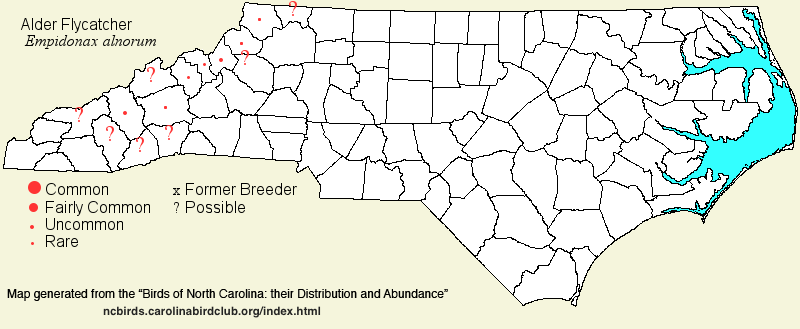 |  |
|
Alder Flycatcher - Empidonax alnorum TYRANNIDAE Members: | Search Common: Search Scientific: |
|
|
|||||||
| General Comments | Prior to 1973, Alder and Willow flycatchers were considered as a single species -- Traill's Flycatcher. Unlike nearly all other "splits" in the bird world, which are "judgement" calls as to whether the two new species interbreed or might interbreed (e.g., Oak and Juniper titmice; Winter and Pacific wrens), this split was of two different taxa with different songs and calls. These "cryptic" species -- like the splits for Tropical and Couch's kingbirds, and for Boat-tailed and Great-tailed grackles -- are sympatric, that is, their breeding ranges overlap, and the different songs and calls, as well as habitats, keep them genetically isolated. Alders are the rarest of the four Empidonax species that nest in the state, and visually they are essentially identical to Willow Flycatchers; and they look enough like Least and Acadian flycatchers that identification of silent birds, such as downstate, is practically impossible without measurements (such as through mist-netting). To date, there are apparently no records of mist-netted birds in the state, indicating its genuine rarity as a migrant east of the mountains. It breeds locally at middle and high elevations in the mountains, favoring saplings and small trees, such as regenerating burned forests, bog margins, and various thickets, such as Green Alder stands at Roan Mountain. As with the Willow Flycatcher, it is a relatively new breeder to the state, not being first recorded in summer until 1972. | ||||||
| Breeding Status | Breeder | ||||||
| NC BRC List | Definitive | ||||||
| State Status | SR | ||||||
| U.S. Status | |||||||
| State Rank | S2B | ||||||
| Global Rank | G5 | ||||||
| Coastal Plain | Transient. Status very poorly known, but apparently casual to (at best) very rare. There are only three reports, of a singing bird at Southern Pines on 1 May 1994 [Chat 59:10 link], a bird heard calling on 4 Jun 2003 at Bodie Island [Chat 67:154 link], and one seen and heard calling in the Sandhills Game Land (Scotland), 20 Aug 2017. Apparently no known banding records to indicate that it routinely passes through the province. | ||||||
| Piedmont | Transient; apparently very rare. Very poorly known, though possible regular in both spring and fall. However, there are few reports of birds singing or calling, and thus it may well be genuinely rare, especially as there seem to be no records of birds captured and measured at banding stations. There are only about 12 records, nine from May, and three from fall migration (16 Aug - 10 Oct). Peak counts: one. | ||||||
| Mountains | Summer resident; breeding, mainly above 3,500 feet elevation. Generally uncommon and local, with the southern extent of the range being in extreme southern Haywood. Numbers seem to have slightly increased since about 1990, and also birds have been reported at lower elevations (down to about 2,800 feet) in recent years. This is probably the latest breeding species in the state to arrive on its nesting grounds, usually not until mid-May (after 10 May), and they are present until Aug or Sep. However, departure dates are difficult to determine unless birds are heard calling. Peak counts: 36, spring bird count in the Shining Rock Wilderness and Black Balsam area, southern Haywood, 15 May 2010. | ||||||
| Finding Tips |
Some of the better sites for finding the species are the road to the Shining Rock Wilderness and Black Balsam areas of Pisgah National Forest -- mostly along the Forest Road at Blue Ridge Parkway milepost 420.2 (Haywood), and Roan Mountain near Carvers Gap. *** | ||||||
| Attribution | LeGrand[2023-08-10], LeGrand[2023-03-24], LeGrand[2021-09-04] | ||||||
| NC Map Map depicts all counties with a report (transient or resident) for the species. | Click on county for list of all known species. |
| NC Breeding Season Map Map depicts assumed breeding season abundance for the species. |  |